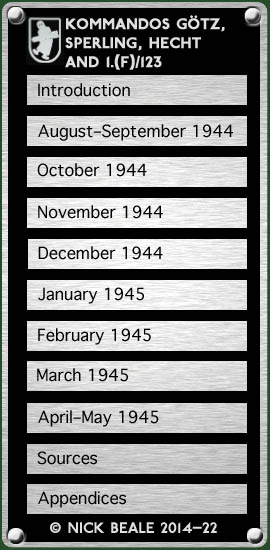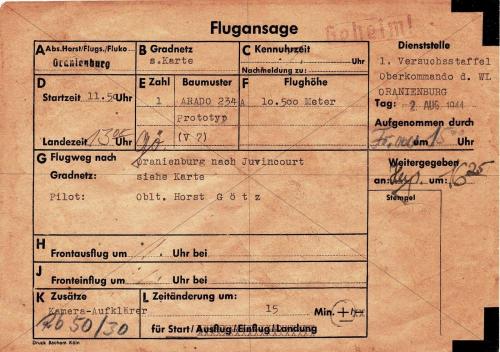|
An order for Ar 234 operations in the West was issued by Luftflotte 3 on 24 July: sorties were to concentrate on the Allied beach head — with Cherbourg as the critical point — and not, at first, on the English mainland. British Intelligence quite soon learned, from an intercepted report, of the world’s first jet reconnaissance operation which took place over the Normandy beach head from 13.32–15.25 GMT on 2 August 1944. They thought that it had been carried out by the Versuchsverband Ob.d.L. and an earlier communication from a Japanese attaché had led them to believe that the aircraft involved was the Me 262. As is now well known, this pioneering mission was flown from Juvincourt in France by Oblt. Erich Sommer of the Versuchsverband OKL (the British were unaware that it had been renamed) in the Arado Ar 234 V7 (W.Nr. 130007, T9+MH). The detachment’s other pilot, Hptm. Horst Götz landed the Ar 234 V5 (W.Nr. 130005, T9+LH) in Juvincourt shortly before Sommer completed this flight. The report revealed that the first operation would have been flown on 1 August but for bad weather (the bane of Ar 234 reconnaissance for the remainder of the war, as will become apparent) and that only two fuelled-up “assisted take-off devices” (rocket packs) were to hand, the expected supply not having arrived. Photographs survive from the inaugural flight, from another by Sommer on the 4th and from a sortie over the lodgement by Götz on the afternoon of 12 August. These are marked as having been processed by 1.(F)/121 and 1./NAG 13 (units of Luftflotte 3 flying the Me 410 and Bf 109 respectively).
The 2 August sortie earned the following entry in the war diary of Oberbefehlshaber West: Abrupt [high-speed?] aerial reconnaissance carried out of the entire sea area between the mouth of the Orne and Cherbourg yielded a surprisingly high number of enemy transport ships (about 1.2 million Gross Registered Tons) but still with only meagre protection from heavy ships. Instead, numerous smaller gun-carriers [Motor Gun Boats or Landing Craft Gun?]. This result from the first comprehensive reconnaissance in the Seine Bay confirms the previous assessment that the enemy’s main points of concentration lie in the present landing area. The two Arados remained at Juvincourt until the Allied breakout necessitated their withdrawal to Chièvres, Belgium on 28 August. The first BP heard of the name Kdo. Sperling was on the 30th in connection with the detachment’s next transfer, to the Dutch aerodrome of Volkel, supplies being forwarded there from both Chièvres and Florennes. En route from Juvincourt to Chièvres in the V5, Horst Götz had been fired on by friendly Flak and decided to take his damaged aircraft to Germany for repairs. What happened next was revealed to the Allies in a message of 2 September from Sommer to FAG 123 in Luxembourg-Sandweiler: All that is known is: T9+LH was forced to make a crash landing as a result of a direct hit from Flak. The landing was made in Oranienburg. After landing, it was completely destroyed by a Fw 190 which was taking off. It seems that for the next four weeks the Kommando consisted of a single aircraft. At 07.30 hrs. on 2 September, FAG 123’s Kommandeur notified 6.(F)/213 that Oblt. Götz could be reached at Volkel (Götz was probably still in bandages after getting fragments in his face and eyes during his recent crash landing). Another signal was sent on 2 September, by 6.(F)/123. It was addressed to the parent Gruppe and the subject was the transfer of a Sonderkommando but: (1) The Wireless Technical Special Detachment of the Führungsstab is in Deelen and contact has been made with it. Working together in close collaboration promises the best results. (2) Transfer of the Special Detachment [Sonderkommando] is impossible as it is dependent for its observations on the reports of the Jagddivision. (3) Telephonic communication with the Special Detachment not guaranteed in the event of transfer, as the lines [words missed] by terrorists … [remainder not seen] Volkel was bombed on 3 September so the Kommando retreated to Rheine, west of Osnabrück and close to the German-Dutch border. They carried out photo-reconnaissance of the Albert Canal on 12 September, bringing back extensive information on which bridges were destroyed or intact. Luftflotte 3’s orders for FAG 123 the next day were for coverage of troop movements out of 21 Army Group’s bridgehead over the Meuse–Escaut (Maas–Scheldt) Canal at Beringen and of airfields around the Wash, especially any occupied by gliders. The latter instruction suggests that, four days before Operation Market-Garden was launched, the Germans already feared or suspected an airborne assault. At 16.30 on 17 September, as the landings were taking place, the Luftwaffe’s liaison to Ob. West advised that: "The Arado 264 [sic] which was to have reconnoitred SE England in accordance with the wishes of the Führer could not take off owing to damage incurred during the air attack on its dispersal”. On the second day of the Allied operation, Luftflotte 3 ordered the extension of reconnaissance to the Thames Estuary, Harwich and Great Yarmouth. Kommando Götz (the alternative name for Sperling) was to make its aircraft ready for operations immediately and “emergency measures” must be taken to get Rheine working again after Allied bombing. By the 21st of the month, the Kommando was being ordered to cover airfields in the region bounded by St. Quentin, Paris and Reims and was to return to the same area on the 22nd: The main thing is to establish how far the enemy air force has moved forward in France. Bridges at Beringen are to be flown over and are to be covered by P/R in order to establish position and effects of hits in the last composite a/c £Mistel£ operation. Next day Ar 234 B-2 W.Nr. 140112 was delivered to the Versuchsverband; marked T9+GH, it would become Horst Götz’s regular machine. On the 26th the Kommando was once again assigned the Paris–Reims area and the Beringen bridges, a task unchanged on the 27th save for an instruction to ascertain whether rail transport was running again in the liberated areas. The morning of 28 September saw Erich Sommer flying a mission which included photographing his former base at Juvincourt, and Horst Götz asking FAG 123 to collect a film containing photographs of the Paris–Reims–St. Quentin area and of the Albert Canal. The unit’s orders for the following day were to photograph harbours in the Thames Estuary and England’s east coast as far as Great Yarmouth as well as airfields up to the Wash. continued on next page …
|
|||||||||


